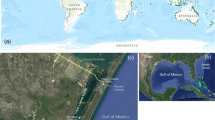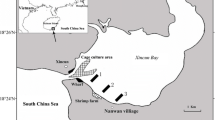Abstract
Microbial activity in permeable tidal flat margin sediments is enhanced by two main processes. First, organic matter is supplied by rapid sedimentation at prograding tidal flat margins. Second, surface and deep pore water advection lead to a replenishment of the dissolved organic matter and sulfate pools. Increasing microbial activity towards the low water line is reflected in sulfate and methane profiles as well as in total cell numbers, sulfate reduction rates, and remineralization products. The impact of high sedimentation rates on pore water biogeochemistry is confirmed by inverse modeling reproducing the depth profiles obtained by measurements. In central parts of the tidal flats, low sedimentation rates and pore water flow velocities limit microbial activity despite the high availability of electron acceptors for microbial respiration such as sulfate. Therefore, tidal flat margins with high microbial activity are of special importance for budgeting biogeochemical cycling in tidal flat areas.









Similar content being viewed by others
References
Beck M, Dellwig O, Kolditz K, Freund H, Liebezeit G, Schnetger B, Brumsack H-J (2007) In situ pore water sampling in deep intertidal flat sediments. Limnol Oceanogr Methods 5:136–144
Beck M, Dellwig O, Holstein JM, Grunwald M, Liebezeit G, Schnetger B, Brumsack H-J (2008a) Sulphate, dissolved organic carbon, nutrients and terminal metabolic products in deep pore waters of an intertidal flat. Biogeochemistry 89:221–238, doi:10.1007/s10533-008-9215-6
Beck M, Dellwig O, Liebezeit G, Schnetger B, Brumsack H-J (2008b) Spatial, seasonal and tidal variations of sulphate, DOC, and nutrients in deep pore waters of intertidal flat sediments. Estuar Coast Shelf Sci 79:307–316, doi:10.1016/j.ecss.2008.04.007
Beck M, Dellwig O, Schnetger B, Brumsack H-J (2008c) Cycling of trace metals (Mn, Fe, Mo, U, V, Cr) in deep pore waters of intertidal flat sediments. Geochim Cosmochim Acta 72:2822–2840, doi:10.1016/j.gca.2008.04.013
Beyer W (1964) Zur Bestimmung der Wasserdurchlässigkeit von Kiesen und Sanden aus der Kornverteilungskurve. Wasserwirtsch Wassertech 14:165–169, WWT
Billerbeck M, Werner U, Polerecky L, Walpersdorf E, de Beer D, Huettel M (2006a) Surficial and deep pore water circulation governs spatial and temporal scales of nutrient recycling in intertidal sand flat sediment. Mar Ecol Prog Ser 326:61–76, doi:10.3354/meps326061
Billerbeck M, Werner U, Bosselmann K, Walpersdorf E, Huettel M (2006b) Nutrient release from an exposed intertidal sand flat. Mar Ecol Prog Ser 316:35–51, doi:10.3354/meps316035
Bosselmann K (2007) Sulfate reduction and iron-manganese cycling in intertidal surface sediments of the southern North Sea. Ph.D. thesis, University of Oldenburg, Germany
Böttcher ME, Rusch A, Höpner T, Brumsack H-J (1997) Stable sulfur isotope effects related to local intense sulfate reduction in a tidal sandflat (southern North Sea): results from loading experiments. Isotopes Environ Health Stud 33:109–129, doi:10.1080/10256019708036345
Böttcher ME, Oelschlager B, Höpner T, Brumsack H-J, Rullkötter J (1998) Sulfate reduction related to the early diagenetic degradation of organic matter and “black spot” formation in tidal sandflats of the German Wadden Sea (southern North Sea): stable isotope (13C, 34S, 18O) and other geochemical results. Org Geochem 29:1517–1530, doi:10.1016/S0146-6380(98)00124-7
Böttcher ME, Hespenheide B, Llobet-Brossa E, Beardsley C, Larsen O, Schramm A, Wieland A, Böttcher G, Berninger UG, Amann R (2000) The biogeochemistry, stable isotope geochemistry, and microbial community structure of a temperate intertidal mudflat: an integrated study. Cont Shelf Res 20:1749–1769, doi:10.1016/S0278-4343(00)00046-7
Boudreau BP (1992) A kinetic model for microbic organic-matter decomposition in marine sediments. FEMS Microbiol Ecol 102:1–14, doi:10.1111/j.1574-6968.1992.tb05789.x
Caetano M, Falcão M, Vale C, Bebianno MJ (1997) Tidal flushing of ammonium, iron and manganese from inter-tidal sediment pore waters. Mar Chem 58:203–211, doi:10.1016/S0304-4203(97)00035-2
Chang TS, Flemming BW, Tilch E, Bartholomä A, Wöstmann R (2006) Last Holocene stratigraphic evolution of a back-barrier tidal basin in the East Frisian Wadden Sea, southern North Sea: transgressive deposition and its preservation potential. Facies 52:329–340, doi:10.1007/s10347-006-0080-2
Chang TS, Flemming BW, Bartholomä A (2007) Distinction between sortable silts and aggregated particles in muddy intertidal sediments of the East Frisian Wadden Sea, southern North Sea. Sed Geol 202:453–463, doi:10.1016/j.sedgeo.2007.03.009
Flemming BW, Davis RA Jr (1994) Holocene evolution, morphodynamics and sedimentology of the Spiekeroog barrier island system (southern North Sea). Senckenb Marit 24:117–155
Freese E, Köster J, Rullkötter J (2008) Origin and composition of organic matter in tidal flat sediments form the German Wadden Sea. Org Geochem 39:820–829, doi:10.1016/j.orggeochem.2008.04.023
Gittel A, Mußmann M, Sass H, Cypionka H, Könneke M (2008) Identity and abundance of active sulfate-reducing bacteria in deep tidal flat sediments determined by directed cultivation and CARD-FISH analysis. Environ Microbiol 10:2645–2658, doi:10.1111/j.1462-2920.2008.01686.x
Grasshoff K, Kremling K, Ehrhardt M (1999) Methods of seawater analysis. Wiley, New York
Grunwald M, Dellwig O, Liebezeit G, Schnetger B, Reuter R, Brumsack H-J (2007) A novel time-series station in the Wadden Sea (NW Germany): first results on continuous nutrient and methane measurements. Mar Chem 107:411–421, doi:10.1016/j.marchem.2007.04.003
Grunwald M, Dellwig O, Beck M, Dippner JW, Freund JA, Kohlmeier C, Schnetger B, Brumsack H-J (2009) Methane in the southern North Sea: Sources, spatial distribution and budgets. Estuar Coast Shelf Sci. doi:10.1016/j.ecss.2008.11.021
Huettel M, Rusch A (2000) Transport and degradation of phytoplankton in permeable sediment. Limnol Oceanogr 45:534–549
Huettel M, Ziebis W, Forster S (1996) Flow-induced uptake of particulate matter in permeable sediments. Limnol Oceanogr 41:309–322
Huettel M, Ziebis W, Forster S, Luther GW (1998) Advective transport affecting metal and nutrient distributions and interfacial fluxes in permeable sediments. Geochim Cosmochim Acta 62:613–631, doi:10.1016/S0016-7037(97)00371-2
Jørgensen BB (1982) Mineralization of organic matter in the sea bed—the role of sulfate reduction. Nature 296:643–645, doi:10.1038/296643a0
Kallmeyer J, Ferdelman TG, Weber A, Fossing H, Jørgensen BB (2004) A cold chromium distillation procedure for radiolabeled sulfide applied to sulfate reduction measurements. Limnol Oceanogr Methods 2:171–180
Kim BS, Oh HM, Kang H, Chun J (2005) Archaeal diversity in tidal flat sediment as revealed by 16S rDNA analysis. J Microbiol 43:144–151
Köpke B, Wilms R, Engelen B, Cypionka H, Sass H (2005) Microbial diversity in coastal subsurface sediments: a cultivation approach using various electron acceptors and substrate gradients. Appl Environ Microbiol 71:7819–7830, doi:10.1128/AEM.71.12.7819-7830.2005
Kunz H (1993) Klimaänderungen und ihre Folgen für Wasserhaushalt, Gewässernutzung und Gewässerschutz. In: Schellnhuber HJ, Sterr H (eds) Klimaänderung und Küste. Springer, Berlin, pp 97–136
Liebezeit G, Behrends B, Kraul T (1996) Variability of nutrients and particulate matter in backbarrier tidal flat of the East Frisian Wadden Sea. Senckenb Marit 26:195–202
Llobet-Brossa E, Rabus R, Böttcher ME, Könneke M, Finke N, Schramm A, Meyer RL, Grotzschel S, Rossello-Mora R, Amann R (2002) Community structure and activity of sulfate-reducing bacteria in an intertidal surface sediment: a multi-method approach. Aquat Microb Ecol 29:211–226, doi:10.3354/ame029211
Lunau M, Lemke A, Walther K, Martens-Habbena W, Simon M (2005) An improved method for counting bacteria in samples with high proportions of particle-associated cells by epifluorescence microscopy: effective detachment, low background fluorescence and excellent cell visibility. Environ Microbiol 7:961–968, doi:10.1111/j.1462-2920.2005.00767.x
Poremba K, Tillmann U, Hesse KJ (1999) Tidal impact on planktonic primary and bacterial production in the German Wadden Sea. Helgol Mar Res 53:19–27, doi:10.1007/PL00012133
Precht E, Franke U, Polerecky L, Huettel M (2004) Oxygen dynamics in permeable sediments with wave-driven pore water exchange. Limnol Oceanogr 49:693–705
Røy H, Lee JS, Jansen S, de Beer D (2008) Tide-driven deep pore-water flow in intertidal sand flats. Limnol Oceanogr 53:1521–1530
Rusch A, Huettel M (2000) Advective particle transport into permeable sediments—evidence from experiments in an intertidal sandflat. Limnol Oceanogr 45:525–533
Rusch A, Forster S, Huettel M (2001) Bacteria, diatoms and detritus in an intertidal sandflat subject to advective transport across the water–sediment interface. Biogeochemistry 55:1–27, doi:10.1023/A:1010687322291
Rusch A, Huettel M, Wild C, Reimers CE (2006) Benthic oxygen consumption and organic matter turnover in organic-poor, permeable shelf sands. Aquat Geochem 12:1–19, doi:10.1007/s10498-005-0784-x
Rütters H, Sass H, Cypionka H, Rullkötter J (2002) Microbial communities in a Wadden Sea sediment core—clues from analyses of intact glyceride lipids, and released fatty acids. Org Geochem 33:803–816, doi:10.1016/S0146-6380(02)00028-1
Sass AM, Sass H, Coolen MJL, Cypionka H, Overmann J (2001) Microbial communities in the chemocline of a hypersaline deep-sea basin (Urania basin, Mediterranean Sea). Appl Environ Microbiol 67:5392–5402, doi:10.1128/AEM.67.12.5392-5402.2001
Stanev EV, Brink-Spalink G, Wolff J-O (2007) Sediment dynamics in tidally dominated environments controlled by transport and turbulence: a case study for the East Frisian Wadden Sea. J Geophys Res 112:C04018, doi:10.1029/2005JC003045
Tilch E (2003) Oszillation von Wattflächen und deren fossiles Erhaltungspotential (Spiekerooger Rückseitenwatt, südliche Nordsee). Berichte, Fachbereich Geowissenschaften, Universität Bremen, Nr. 222
Van Beusekom JEE, de Jonge VN (2002) Long-term changes in Wadden Sea nutrient cycles: importance of organic matter import from the North Sea. Hydrobiologia 475/476:185–194, doi:10.1023/A:1020361124656
Volkman JK, Rohjans D, Rullkötter J, Scholz-Böttcher BM, Liebezeit G (2000) Sources and diagenesis of organic matter in tidal flat sediments from the German Wadden Sea. Cont Shelf Res 20:1139–1158, doi:10.1016/S0278-4343(00)00016-9
Wilms R, Köpke B, Sass H, Chang TS, Cypionka H, Engelen B (2006a) Deep biosphere-related bacteria within the subsurface of tidal flat sediments. Environ Microbiol 8:709–719, doi:10.1111/j.1462-2920.2005.00949.x
Wilms R, Sass H, Köpke B, Köster J, Cypionka H, Engelen B (2006b) Specific bacterial, archaeal and eukaryotic communities in tidal-flat sediments along a vertical profile of several meters. Appl Environ Microbiol 72:2756–2764, doi:10.1128/AEM.72.4.2756-2764.2006
Wilms R, Sass H, Köpke B, Cypionka H, Engelen B (2007) Methane and sulfate profiles within the subsurface of a tidal flat are reflected by the distribution of sulfate-reducing bacteria and methanogenic archaea. FEMS Microbiol Ecol 59:611–621, doi:10.1111/j.1574-6941.2006.00225.x
Wilson AM, Gardner LR (2006) Tidally driven groundwater flow and solute exchange in a marsh: Numerical simulations. Water Resour Res 42(1):W01405, doi:10.1029/2005WR004302
Wirtz K (2003) Control of biochemical cycling by mobility and metabolic strategies of microbes in the sediments: an integrated model study. FEMS Microbiol Ecol 46:295–306, doi:10.1016/S0168-6496(03)00196-X
Ziebis W, Huettel M, Forster S (1996) Impact of biogenic sediment topography on oxygen fluxes in permeable seabeds. Mar Ecol Prog Ser 140:227–237, doi:10.3354/meps140227
Acknowledgments
We thank the captains and the crews of RV Senckenberg and the tjalk Spes Mea for support during sampling campaigns. Furthermore, we wish to thank H. Nicolai and his colleagues for their assistance during sediment coring and construction of pore water samplers. A. Bartholomä, M. Groh, Y. Hilker, S. Kleindienst, C. Lehners, R. Neumann, S. Reischke, M. Pilzen, and M. Wilsenack are thanked for their assistance during sampling and experimental work. This work was financially supported by Deutsche Forschungsgemeinschaft (DFG) within the research group “BioGeoChemistry of Tidal Flats”.
Author information
Authors and Affiliations
Corresponding author
Additional information
Responsible Editor: Meinhard Simon
Rights and permissions
About this article
Cite this article
Beck, M., Köster, J., Engelen, B. et al. Deep pore water profiles reflect enhanced microbial activity towards tidal flat margins. Ocean Dynamics 59, 371–383 (2009). https://doi.org/10.1007/s10236-008-0176-z
Received:
Accepted:
Published:
Issue Date:
DOI: https://doi.org/10.1007/s10236-008-0176-z




